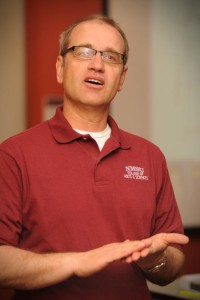
Date: 05/07/2014
Writer: Isabel A. Rodriguez, 575-646-7066, [email protected]
A team of faculty led by Professor Stefan Zollner of New Mexico State University has received a grant of about $300,000 for the acquisition of a high-resolution, high-intensity X-ray diffractometer and reflectometer.
The grant was awarded through the Army Research Office from the Department of Defense Research and Education Program. The new instrument will be housed in Gardiner Hall and will replace an older diffractometer with lower resolution and intensity.
“We can perform thickness measurements with this instrument; we can measure very thin structures,” Zollner said. “Crystals are made out of atoms which have regular arrangements. There are bonds between the atoms and these bonds have certain lengths and the atoms are certain distances apart. This device can measure distances between atoms, bond angles, lengths of crystal structures and film thickness, and can be applied to a broad range of materials – semiconductors, metals and oxides.”
Zollner, head of the physics department in the College of Arts and Sciences, gave a presentation of his work at a Research Rally held Friday, May 2, at NMSU.
The device will aid scientists pursuing a variety of research areas at NMSU, including Zollner’s colleagues Heinz Nakotte and Edwin Fohtung of the physics department and Shuguang Deng and Hongmei Luo of the chemical engineering department.
“This acquisition is truly an interdisciplinary collaboration of two departments in two different colleges,” Zollner said.
“I commend Dr. Zollner for his efforts to secure this award,” said Vice President for Research Vimal Chaitanya. “Once operational, this XRD will fill a gap that our researchers presently have in order to become more competitive in pursuing research endeavors in materials science and engineering.”
Zollner, an expert in the areas of semiconductor process integration, complementary metal-oxide semiconductors, device engineering, semiconductor metrology and process control, and optical properties of materials, said he is especially interested in preparing students in the operation of these instruments.
“My goal is training students so they can be successful and get jobs,” he said. “It would be a misconception to think that only faculty perform the research on campus. I would rather compare a faculty member to the director of our marching band, who supports and directs the band from the sideline; but the music is produced by the students on the field. It is the same with research.
“I’m confident we’ve only seen the tip of the iceberg in semiconductor technologies and many innovations and energy applications are still ahead of us.”
A self-described basic scientist, Zollner explained that many consumer technologies (smart phones, for example, which contain semiconductor chips) would not exist without basic research at the university level.
Physics graduate student Dennis Trujillo from Espanola will be in charge of maintaining the XRD and will train others on the operation of the instrument. He will be assisted by Luis Barrera from Las Cruces, a double major in mechanical engineering and engineering physics.
Although there is no semiconductor industry in Las Cruces, there is a plant in Albuquerque, as well as state-of-the-art semiconductor plants in Austin and Phoenix.
During the rally, Luo gave a brief presentation of the research she is conducting, researching chemical solutions to creating metal oxide films.
The Department of Defense has awarded more than $1.7 million in grants and contracts to the NMSU Department of Physics. These funds are used to train undergraduate and graduate students and acquire equipment.
“You look at this project and you see research, teaching and outreach all coming together,” said Greg Fant, associate vice president and deputy provost. “That’s what we’re all about. Bringing in the industry from Dr. Zollner’s background (he previously worked at Motorola and IBM) and showing that to our students and making things grow, we’re much appreciative. These competitive grants are hard to get. We’re proud of the work he’s doing.”
The XRD is expected to be installed this fall.
Watch this video on YouTube at http://youtu.be/8yTugULAQEE.
For more information on this, and other NMSU stories, visit the NMSU News Center.